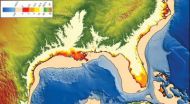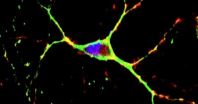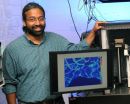(Press-News.org) Boulder, CO, USA – Sea levels are rising faster than expected from global warming, and University of Colorado geologist Bill Hay has a good idea why. The last official IPCC report in 2007 projected a global sea level rise between 0.2 and 0.5 meters by the year 2100. But current sea-level rise measurements meet or exceed the high end of that range and suggest a rise of one meter or more by the end of the century.
"What's missing from the models used to forecast sea-level rise are critical feedbacks that speed everything up," says Hay. He will be presenting some of these feedbacks in a talk on Sunday, 4 Nov., at the meeting of The Geological Society of America in Charlotte, North Carolina, USA.
One of those feedbacks involves Arctic sea ice, another the Greenland ice cap, and another soil moisture and groundwater mining.
"There is an Arctic sea ice connection," says Hay, despite the fact that melting sea ice -- which is already in the ocean -- does not itself raise sea level. Instead, it plays a role in the overall warming of the Arctic, which leads to ice losses in nearby Greenland and northern Canada. When sea ice melts, Hay explains, there is an oceanographic effect of releasing more fresh water from the Arctic, which is then replaced by inflows of brinier, warmer water from the south.
"So it's a big heat pump that brings heat to the Arctic," says Hay. "That's not in any of the models." That warmer water pushes the Arctic toward more ice-free waters, which absorb sunlight rather than reflect it back into space like sea ice does. The more open water there is, the more heat is trapped in the Arctic waters, and the warmer things can get.
Then there are those gigantic stores of ice in Greenland and Antarctica. During the last interglacial period, sea level rose 10 meters due to the melting of all that ice -- without any help from humans. New data suggests that the sea-level rise in the oceans took place over a few centuries, according to Hay.
"You can lose most of the Greenland ice cap in a few hundred years, not thousands, just under natural conditions," says Hay. "There's no telling how fast it can go with this spike of carbon dioxide we are adding to the atmosphere."
This possibility was brought home this last summer as Greenland underwent a stunning, record-setting melt. The ice streams, lubricated by water at their base, are speeding up.
Hay notes, "Ten years ago we didn't know much about water under the Antarctic ice cap." But it is there, and it allows the ice to move -- in some places even uphill due to the weight of the ice above it.
"It's being squeezed like toothpaste out of a tube," explains Hay. The one thing that's holding all that ice back from emptying into the sea is the grounded ice shelves acting like plugs on bottles at the ends of the coastal glaciers. "Nobody has any idea how fast that ice will flow into the oceans once the ice shelves are gone."
Another missing feedback is the groundwater being mined all over the world to mitigate droughts. That water is ultimately added to the oceans (a recent visualization of this effect in the U.S. was posted by NASA's Earth Observatory: http://earthobservatory.nasa.gov/IOTD/view.php?id=79228).
All of these are positive feedbacks speeding up the changes in climate and sea-level rise.
"You would expect negative feedbacks to creep in at some point," says Hay. "But in climate change, every feedback seems to go positive." The reason is that Earth's climate seems to have certain stable states. Between those states things are unstable and can change quickly. "Under human prodding, the system wants to go into a new climate state."
INFORMATION:
WHAT: Could Estimates of the Rate of Future Sea-Level Rise Be Too Low?
WHEN: Sunday, 4-November, 9:15-9:30 a.m.
WHERE: Charlotte Convention Center, Room 219AB
ABSTRACT: https://gsa.confex.com/gsa/2012AM/finalprogram/abstract_209198.htm
CONTACT:
Prof. Bill Hay
University of Colorado, Boulder
+1 (970) 586-8698
Find out what else is new and newsworthy by browsing the complete technical program schedule at https://gsa.confex.com/gsa/2012AM/finalprogram/.
To identify presentations in specific areas of interest, search topical sessions by discipline categories or sponsors using the drop-down menus at www.geosociety.org/meetings/2012/sessions/topical.asp, or use your browser's "find" feature to search for keywords or convener names.
Representatives of the media and public information officers from universities, government agencies, and research institutions, may participate in technical sessions, field trips, and other special events at the Annual Meeting. Eligible media personnel will receive complimentary registration and are invited to use GSA's newsroom facilities while at the meeting. Journalists and PIOs must pay for any short courses or field trips in which they wish to participate.
For information on media eligibility, go to www.geosociety.org/meetings/2012/media.htm. Media personnel may register onsite in the GSA Newsroom (room 204) at the Charlotte Convention Center. Wireless Internet access and a quiet space for interviews will be provided in the newsroom, along with beverages and light snacks throughout the day.
Newsroom Hours of Operation
Saturday, 3 Nov., 3 p.m. to 5 p.m.
Sunday, 4 Nov., through Tuesday, 6 Nov., 7:30 a.m. to 6 p.m.
Wednesday, 7 Nov., 7:30 a.m. to 5:30 p.m.
Newsroom telephone number (incoming calls): +1-704-339-6207 (starting Saturday afternoon).
Contact Christa Stratton, GSA Director of Communications & Marketing, for additional information and assistance.
www.geosociety.org/meetings/2012/
The Geological Society of America, founded in 1888, is a scientific society with more than 25,000 members from academia, government, and industry in more than 100 countries. Through its meetings, publications, and programs, GSA enhances the professional growth of its members and promotes the geosciences in the service of humankind. Headquartered in Boulder, Colorado, USA, GSA encourages cooperative research among earth, life, planetary, and social scientists, fosters public dialogue on geoscience issues, and supports all levels of earth science education.
www.geosociety.org
Why seas are rising ahead of predictions
GSA Annual Meeting presentation: Could estimates of the rate of future sea-level rise be too low?
2012-11-02
ELSE PRESS RELEASES FROM THIS DATE:
Bird tree tells new tale of evolution
2012-11-02
Contact:
Arne Mooers, 778.782.3979, amooers@sfu.ca
Carol Thorbes, PAMR, 778.782.3035, cthorbes@sfu.ca END ...
Berkeley Lab scientists help develop promising therapy for Huntington's disease
2012-11-02
There's new hope in the fight against Huntington's disease. A group of researchers that includes scientists from the U.S. Department of Energy's Lawrence Berkeley National Laboratory (Berkeley Lab) have designed a compound that suppresses symptoms of the devastating disease in mice.
The compound is a synthetic antioxidant that targets mitochondria, an organelle within cells that serves as a cell's power plant. Oxidative damage to mitochondria is implicated in many neurodegenerative diseases including Alzheimer's, Parkinson's, and Huntington's.
The scientists administered ...
The ins and outs of in-groups and out-groups
2012-11-02
We humans organize ourselves in myriad kinds of social groups, from scout troops and sports teams to networks of friends, colleagues, or classmates. But how do these social groups work? How do we decide whom to trust and whom to follow? And how do we deal with people that don't seem to fit the norms of our social groups?
New research published in Psychological Science, a journal of the Association for Psychological Science, explores these issues by examining various facets of social perception and behavior.
The Herding Hormone: Oxytocin Stimulates In-Group Conformity
Mirre ...
Bigger human genome pool uncovers rarer variants
2012-11-02
Contact:
Iman Hajirasouliha, 778.782.7040, 604.418.4834 (cell), imanh@sfu.ca
Carol Thorbes, PAMR, 778.782.3035, cthorbes@sfu.ca
Flickr: http://at.sfu.ca/skirFz END ...
UC Davis scientists identify new target for lung cancer treatment
2012-11-02
(SACRAMENTO, Calif.) — A team of UC Davis investigators has discovered a protein on the surface of lung cancer cells that could prove to be an important new target for anti-cancer therapy. A series of experiments in mice with lung cancer showed that specific targeting of the protein with monoclonal antibodies reduced the size of tumors, lowered the occurrence of metastases and substantially lengthened survival time. The findings will be published in the November issue of Cancer Research.
"Lung cancer continues to be one of the biggest killers in the United States, and ...
How the negative trumps the positive in politics
2012-11-02
Negatively framed political attitudes ("I don't like Obama") are stronger than positively framed attitudes ("I like Romney"), and this effect is strengthened when people think more deeply about the issues involved.
That is the finding of a paper published in the latest issue of the British Journal of Social Psychology by George Bizer, a psychology professor at Union College in Schenectady, N.Y.
Bizer and his co-authors Iris Žeželj (University of Belgrade) and Jamie Luguri (Yale University) presented participants with information about two fictional (though ostensibly ...
New light on the genetic basis of inflammatory diseases
2012-11-02
In one of the largest studies of its kind ever conducted, an international team of scientists has thrown new light on the genetic basis of the inflammatory bowel diseases (IBD). Crohn's disease and ulcerative colitis, the two most common forms of IBD, are chronic inflammatory digestive disorders affecting 230,000 Canadians. Dr. John Rioux, researcher at the Montreal Heart Institute and Associate Professor of Medicine at the Université de Montréal, is one of the researchers who have identified 71 genetic regions newly associated with inflammatory bowel disease (IBD), increasing ...
Combination treatment may improve survival of breast cancer patients with brain metastases
2012-11-02
Adding an angiogenesis inhibitor to treatment with a HER2-inhibiting drug could improve outcomes for patients with HER2-positive breast cancer who develop brain metastases. In their report published online in PNAS Plus, Massachusetts General Hospital (MGH) investigators report the first preclinical study combining antiangiogenic and anti-HER2 drugs in an animal model of brain metastatic breast cancer.
"We have shown dramatic improvement in survival by slowing the growth of brain metastatic, HER2-amplified breast cancer," says Rakesh Jain, PhD, director of the Steele ...
Softening arteries, protecting the heart
2012-11-02
PHILADELPHIA - Arterial stiffening has long been considered a major risk factor for cardiovascular disease. Keeping arteries soft and supple might reduce disease risk, but the mechanisms of how arteries stave off hardening has remained elusive.
Researchers from the Perelman School of Medicine, University of Pennsylvania, Wistar Institute, and The Children's Hospital of Philadelphia have discovered that the protein apolipoprotein E (apoE) plays a major role in maintaining arterial softness by suppressing production of the extracellular matrix, a network of connective ...
Iowa State, Ames Lab researchers find 3 unique cell-to-cell bonds
2012-11-02
AMES, Iowa – The human body has more than a trillion cells, most of them connected, cell to neighboring cells.
How, exactly, do those bonds work? What happens when a pulling force is applied to those bonds? How long before they break? Does a better understanding of all those bonds and their responses to force have implications for fighting disease?
Sanjeevi Sivasankar, an Iowa State assistant professor of physics and astronomy and an associate of the U.S. Department of Energy's Ames Laboratory, is leading a research team that's answering those questions as it studies ...
LAST 30 PRESS RELEASES:
The vast majority of US rivers lack any protections from human activities, new research finds
Ultrasound-responsive in situ antigen "nanocatchers" open a new paradigm for personalized tumor immunotherapy
Environmental “superbugs” in our rivers and soils: new one health review warns of growing antimicrobial resistance crisis
Triple threat in greenhouse farming: how heavy metals, microplastics, and antibiotic resistance genes unite to challenge sustainable food production
Earthworms turn manure into a powerful tool against antibiotic resistance
AI turns water into an early warning network for hidden biological pollutants
Hidden hotspots on “green” plastics: biodegradable and conventional plastics shape very different antibiotic resistance risks in river microbiomes
Engineered biochar enzyme system clears toxic phenolic acids and restores pepper seed germination in continuous cropping soils
Retail therapy fail? Online shopping linked to stress, says study
How well-meaning allies can increase stress for marginalized people
Commercially viable biomanufacturing: designer yeast turns sugar into lucrative chemical 3-HP
Control valve discovered in gut’s plumbing system
George Mason University leads phase 2 clinical trial for pill to help maintain weight loss after GLP-1s
Hop to it: research from Shedd Aquarium tracks conch movement to set new conservation guidance
Weight loss drugs and bariatric surgery improve the body’s fat ‘balance:’ study
The Age of Fishes began with mass death
TB harnesses part of immune defense system to cause infection
Important new source of oxidation in the atmosphere found
A tug-of-war explains a decades-old question about how bacteria swim
Strengthened immune defense against cancer
Engineering the development of the pancreas
The Journal of Nuclear Medicine ahead-of-print tip sheet: Jan. 9, 2026
Mount Sinai researchers help create largest immune cell atlas of bone marrow in multiple myeloma patients
Why it is so hard to get started on an unpleasant task: Scientists identify a “motivation brake”
Body composition changes after bariatric surgery or treatment with GLP-1 receptor agonists
Targeted regulation of abortion providers laws and pregnancies conceived through fertility treatment
Press registration is now open for the 2026 ACMG Annual Clinical Genetics Meeting
Understanding sex-based differences and the role of bone morphogenetic protein signaling in Alzheimer’s disease
Breakthrough in thin-film electrolytes pushes solid oxide fuel cells forward
Clues from the past reveal the West Antarctic Ice Sheet’s vulnerability to warming
[Press-News.org] Why seas are rising ahead of predictionsGSA Annual Meeting presentation: Could estimates of the rate of future sea-level rise be too low?



